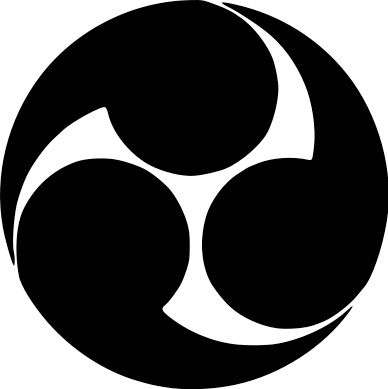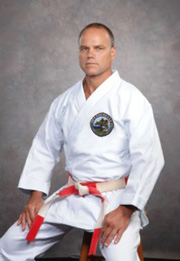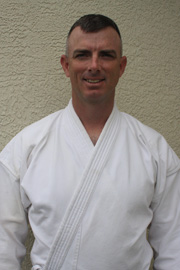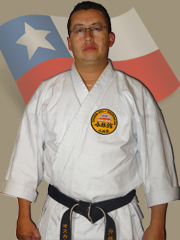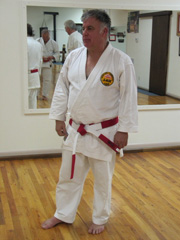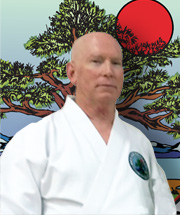THE KENSANKAI KYOSHI |
|||

BIOGRAPHIES AND ARTICLES FROM THE KENSANKAI KYOSHI
ARTICLES:
By Kyoshi Jason Perry: Lessons Relearned: A Few Thoughts on Karate Principles
July 4, 2012 Musa Qala District, Helmand Province, Afghanistan For my karate friends, I thought I would share some thoughts I have had recently on karate principles. I am not able to go to a dojo but I still train and think about karate. It is a little long and somewhat random so forgive the lack of structure and coherence. A few things that have been on my mind follow. I hope you find this enjoyable and maybe even helpful. I also hope you will recognize my intended sincerity and humility and will forgive anything that smacks arrogant or judgmental.
Kutsu o nuide keiko (Remove your shoes and train). When we enter the dojo we remove our shoes and train without their support. Interestingly, it seems the running and athletic fitness world is discovering the value of going sans shoes also. In the book “Born to Run,” Christopher McDougall talks about the Tarahumara people in Mexico who are known to run races that go on for days. While their endurance is noteworthy what is amazing is they run hundreds of miles barefoot. By and large they run injury free. The book has spurred a whole barefoot running movement. Even shod runners espouse an occasional barefoot work out consisting of strides and speed work on the infield of the track. CrossFitters are increasingly using the Vibram Five Fingers to maintain proper balance and stabilizer muscle fitness. One trip to Joshua Tree National Park and you will see barefoot (Five Finger shod) hikers all over the place. Nike came out with its Nike Free line of running shoes that are supposed to get out of the way of your foot’s natural motion when you run. Over the last few years as I have seen runners and hikers and CrossFitters (including me) latch onto this “new” fad, it occurred to me that I rarely ever worked out in shoes until I began running and wearing combat boots. There is nothing new here at all. It was only after multiple marathons in the cushioniest shoe with good arch support I could find for my medium arched, biomechanically efficient feet and a little bit of age that I began to feel leg and back pain. The only pain I ever experienced in the dojo was due to frozen feet on the concrete deck at the Marine Corps Air Station Cherry Point dojo, or the occasional stubbed toe, cut lip or unintentional kinteki geri. OK, there was that time when Moose broke my ribs during some "light" kumite only weeks before one of my marathons (I ran 18 miles the next morning) but I forgot about that long ago - that was painful and apparently not forgotten. Working out barefoot strengthens muscles that are critical for martial arts. It teaches us how to balance properly. Shoes, by their design cast us forward and off balance us by lifting the heel of the foot. Kutsu o nuide keiko. The Core. It is hard to open an exercise or running magazine without seeing something that involves core strengthening. These articles convince us to get in all sorts of plank positions and strengthen the muscles that stabilize our center. In the Insanity work out, much of the core strengthening is done by lifting the knees high, often while doing jumping exercises. Imagine that, core-specific training. From day one in the dojo we learn about hara. Tuck your hips in, shoulders down, rotate your hips and drive power from your hara. Lift the knee high with the foot of the kicking leg coiled back before driving with the hips. When I was young, my father would have me walk up and down the dojo in zenkutsu dachi with my back straight, hips forward under my shoulders. He would admonish me to move from my hara. He would have me punch a bag with an imaginary pole running through my head to the deck locking my hips and torso at the end of the punch to generate power through my hand. Using a shinai he would check to see if I was maintaining a tight torso by tapping me (OK that might be a little understated but I don’t want CPS showing up and arresting the 75 year old) on the torso. Everything worked the core and if a technique was not executed from the core it was weak. If your core was weak your karate would be weak. As a runner, I realized that running does nothing for the core. Your body will rely on larger muscle groups to generate speed but your core muscles will weaken. Your hips will begin to destabilize and injury will set in. Thus the steady diet of core exercises for runners now found in Runners’ World magazine. Crossfit, Sparta, Insanity, PX90 all emphasize core strengthening through posture and core-specific exercises. Explosive movements and the transfer of energy. If you do Crossfit you will notice there is not a lot of isolating muscles and fatiguing them like you see with weight lifters. The movements are powerful, full-range-of-motion movements that require the transfer of power from one muscle group to another and incorporate timing, balance, and coordination. The kipping pull up is a prime example. While kipping pull ups are easier to do than strict or dead hang pull ups they require a level of coordination, timing and energy transfer you do not get from strict pull ups. Every technique in karate is just that – a transfer of power from one place to another until eventually that power is delivered at the point of impact with all the energy of one’s body behind it. To generate that kind of power requires our feet to grip the deck, our legs to drive our hips forward, our shoulders to rotate but not enough to lose control and eventually to transfer all that moving energy in the form of a strike through the hand into the target area on our opponent. If the timing and coordination of all the disparate muscle groups is off, the strike will be less effective. Like a speed bump in the road the forward energy is interrupted and power is lost. Just like the kipping pull up, the less we get in the way of that power the easier and more efficient our techniques will be. The value of the exercise is not in how hard we can make it but how efficiently we can coordinate the movement of the body. Weight distribution. The barefoot runners talk about running on the toes and allowing our feet to work naturally to absorb shock. They also talk about keeping the feet under the body’s center of gravity instead of landing on the heel which reduces efficiency by interrupting forward motion. Crossfitters advocate driving through the heels when doing squats, wall ball shots or kettlebell swings and keeping your feet underneath your body and tucking the hips at the end of the motion. Both of these techniques are consistent with karate principles. As I learned the techniques taught in these exercise formats they all rang true to me. As I said earlier, I spent a lot of time just walking up and down the dojo in zenkutsu dachi. When I graduated from zenkutsu dachi, dad would let me do neko ashi dachi. What a treat that was (the reader should sense a great deal of sarcasm here). I would literally go to the dojo and walk up and down the dojo until class was over, bow out and go home and eat cheese and crackers with dad while watching baseball games until past my bedtime. But in just walking up and down the floor I learned the very principles we now view as revolutionary. In moving from one stance to another we glide along the deck keeping the hips traveling on an even plane. The ball of the foot is in contact with the floor as we transfer weight. We keep our center of gravity over our feet. This echos much of what the barefoot runners talk about. But we drive with power off the heel. If a shiko dachi is too wide, it is not effective because our center is not supported properly. When we turn around in the dojo we pivot on the heel to generate power. When we punch we pivot on our heel to generate forward motion in our hips and create a solid surface (bone supported by the deck). When power is needed the Crossfitters and Sparta fans will tell you to drive through your heels. Your weight should not be forward when doing kettlebell swings or squat thrusts. Drive through the heels in a powerful motion, tuck the hips at the end as you transfer energy to lift the prescribed weight. I remember a camp I attended with Kevin Roberts. Ridgley Abele sensei taught us these same principles during a class about generating power. He also took us on runs in our gi and taght us about how to run efficiently. I thought it strange at the time but now realize he was teaching us to apply karate principles into all of our activities. Kevin has a picture of he and I on his website standing under a waterfall during that camp. All this sounded very familiar. Think about Kusanku dai when you drive from the shiko dachi to shizentai (hachiji) dachi at the beginning of the kata. The power that drives the hips up comes straight through the heels. If your knees, hips or shoulders are forward of the heels the strength of the technique is lost. If you are up on your toes, your shoulders lurch forward and your hips back; you have no power because you are off balance and the muscles are not able to transfer power efficiently so there is a loss of power in each transition. To get the power needed to execute the technique properly you must explode through your heels keeping everything aligned and sequenced for power. Short intense work outs. A good number of Crossfit workouts only take about 20 minutes. They are intense, high energy workouts that will leave you puking your guts out before you can say, “Fifty Wall Ball Shots.” The Crossfit mascot is Pukey the Clown for crying out loud. The Insanity work out is basically 30-45 minutes of interval training turned on its head with sustained high intensity periods of work with very short breaks followed by subsequent sets of high intensity work. The warm up alone had me in the fetal position in a puddle of my own sweat during week one. Kata, if done with speed and power, can have a similar effect. Try doing all of the kata full power and full speed with a 30 second break between them. Starting at Naihanchi shodan allows you to start with moderate intervals and build to longer more demanding periods of work through Gojuushiho. Then make your way back down from Gojuushiho back to Naihanchi Shodan. Give yourself 30 seconds between kata. Throw Tsuken sunakake, Kubo no kon and Saijutsu dai whatever in there and prepare to get broke off. Intense bursts of effort with short periods of rest will quickly increase stamina, speed and power. Most fights are short and intense so make your kata that way sometimes. Dynamic stretching. In the last few years I have seen an increasing number of articles about the value of dynamic stretching. Dynamic stretching involves active movements of the muscle that bring forth a stretch but are not held in the end position. It loosens the muscles and joints through motion. If you attend a class with Eizo Shimabukuro sensei at his Ginoza, Okinawa dojo you will see this technique but I don’t think it comes from the latest Men’s Health magazine. He’s been doing the same warm up routine since Bill Hayes sensei was a Private. While in the 1980s static stretching (holding a stretch at the end of the movement) was all the rage (think the stretching racks we used to have in the dojo), now in some arenas static stretching is a hiss and a byword. The most effective way to stretch is probably somewhere in between. Since I was a kid we always warmed up lightly then moved the joints by rotating them and swinging them back and forth (dynamic stretching). We would do some bouncing as we stretched and in some cases we would hold the static stretch. I remember Perry sensei counting to 10 as we would dynamically stretch and then hold the last count for a few seconds as in static stretching. These principles are still seen in most of our classes in the dojo today. You will see a mix of static and dynamic stretching which convinces me that karate principles are timeless. I have recently begun to create my own workouts that incorporate what I enjoy about all of these workouts. In Five Fingers I will do 4-5 rounds of 1 KM run followed by 20 kettlebell swings or wall ball shots, followed by a 3 minute round on the heavy bag, then some incline sit ups, elbows to knees, or planks followed by a kata. I will mix in strict pull ups, squat thrusts, switch kicks, burpees or other horrible exercise to keep things interesting. At the end of the workout I feel like I have worked hard and have applied karate principles I have known my whole life. In the desert of Twentynine Palms I would often go on a 6 mile run that consisted of 3 miles then 4 to 6 kata at full speed with a 30 second break between then a 3 mile run back. It was like doing a standard speed day with a warm up, sprints and then a cool down. It is also develops the mind and body to accept hard work when you are tired. I don't have that luxury here in Afghanistan so I stick to my circuits. So why put these thoughts on paper - uhhh interspace? I am not trying to change the way anyone trains or alter what aspect of karate you find attractive. Most of you probably already understand these principles because you had gym memberships and were doing the Nautilus workouts or Arnold’s get huge now workouts that just weren’t giving you the results you seek and discovered the wholeness of a traditional martial work out. The very thing I am just now internalizing. I never transitioned from that experience to karate. I never appreciated the uniqueness of karate as a workout system. I am probably handicapped by the fact that I knew nothing but karate from the time I could walk. Now that I am a little older and more prone to injury and soft midriff syndrome, I need to work out for my physical, spiritual and emotional health. I am reminded after doing all kinds of exercise programs that karate principles are enduring. And therein lies the purpose of this essay. This doesn’t mean I am no longer going to run (with or without shoes), or knock out “Cindy” or “Fight Gone Bad,” or “Dig Deeper!” with Shawn T every once in a while but I do appreciate the martial principles in all the workouts I do. I also work kata into my workouts much more than I used to. Instead of doing kata as a separate part of my regimen, I incorporate kata into my normal routine. We often talk about bunkai and oyo bunkai and find ourselves with our hands on our hips engaged in lively discussions about the intricacies of the techniques embedded in our kata. While this helps us understand the meaning of our art it does not condition our bodies or minds for the combat we so energetically discuss. Occasionally, we should put those important discussions aside and just go fight our way through kata. When I say fight I mean just that – make kata a combative event. Forget the meaning of the technique. The meaning is inherent in the movements themselves. Case in point, just walk up to someone and execute the first technique in Kihon kata. The meaning of the technique will become apparent very quickly whether you were taught the bunkai or not. It is an inherently combative movement. Learn to move with combative intent and commitment and you will learn a skill most of your potential opponents do not possess - and one that is often the decisive factor in an altercation. Dismiss the count and just go fight. Not only will the kata become meaningful in a combative context it will also become a challenging workout that incorporates all the principles that seem to be re-emerging in mainstream fitness. Karatedo ni Hissho. Okinawa's Bushi: Karate Gentlemen Article: Coutesy of Kyoshi Estes
By Charles C. Goodin "My unruly behaviour was not confined to drinking and courtesans. I fought with roughs and thrashed men for imagined insults. The Luchuans are a pacific people, but like all those given to strong drink and leading a primitive life, they would commit acts of nameless cruelty if their blood was stirred. The Luchuans had developed through centuries of practice the peculiar art of self-defence and aggression, known as tekobushi, which consists in making incredibly deft and powerful thrusts of the fist after the fashion of jujitsu or even boxing. This was the only possible mode of self-defence for the Luchuans, who had been prohibited the use of weapons by their double rulers of China and Japan. A Luchuan expert in the deadly art could smash every bone in his victim's body with the thrusts of his arms, as if he had struck with a giant hammer. Not infrequently poor victims were found dead by the road-side bearing marks of terrible blows from naked fists. Near Tsuji at night there were always gangs of roughs supposed to be skilled in tekobushi, who were ready to pick quarrels with unwary strangers." A "Tijikun Bushi" is the worst type, since he is the most likely to harm others, and in the process, impugn the reputation of all other Karate practitioners. Morio Higaonna, /4 who visited me at the Hawaii Karate Museum in August, 2004, explained to me that such a person is also referred to as a "Bushi Gwa," or "small Bushi." "Gwa" is the Hogen word for "small." /5 A "Bushi Gwa" grasps only a small aspect of Karate. Yakusoku Kumite - a discussion: Courtesy of Kyoshi Jason Perry
Yakusoku (約束) means appointment or promise. Kumite (組み手) means to pair hands or spar. Yakusoku kumite, therefore, is a prearranged set of movements done by two people. One is a defender and the other the attacker. Yakusoku kumite offers karateka the opportunity to execute kata-like offensive and defensive movements in a controlled environment. Unlike Jiyu kumite or in actual combat, each individual executes his / her technique with a complete understanding of what his aite (相手) or partner is going to do in response. Practicing Yakusoku kumite has several merits but it also potentially teaches bad habits that if carried over to actual fighting may have unwanted results. If we accept that we fight the way we train, one must understand the demerits of yakusoku kumite and be careful not to allow those practices to become habits in our fighting philosophy or style. Such is the case with any training tool to include kata, makiwara, jiyu kumite or other drills and exercises. Each has its purpose and training objectives but each also falls short of replicating actual combat. I would like to limit my thoughts to yakusoku kumite and offer a few merits and demerits each karateka should consider when training. Merits No training can completely replicate combat, therefore we train different aspects of fighting by means of various methods that stress certain, albeit limited, concepts of fighting. Kata teaches balance, breathing, body mechanics and the fundamentals of combative movement. But to be proficient in kata will not make one a skilled fighter in and of itself. Kata must be applied in the context of the nature of combat such as fluidity, confusion, fear, fatigue, environment, etc. Similarly, yakusoku kumite teaches valuable combat principles. I will offer a few of them here: 1) Maai (間合い): Ma (間) means between or interval and ai (合い) means to meet or merge. Maai is the meeting distance between two combatants. Maai changes based on the individual, the techniques involved, and the intent of the combatant. When properly done, yakusoku kumite can teach karateka how to manage this distance. As the attacker closes the distance to execute a technique the uke or defender (literally receiver) must adjust the distance and direction between the karateka and the aite. Both partners must attempt to adjust the maai to best achieve his/her intent (defend or attack). Maai is a component of combat that can only be learned with a partner. Kata offers ways to close or open distance but has little value in terms of managing maai in a fluid environment with an opposing will. 2) Initiative and timing: Kata can be executed in accordance with the karateka’s own understanding of the timing of the “fight.” One look at modern Japanese shitei kata makes it clear kata timing is not realistic with its slow motion and long pauses for effect. This results in pure theatrics vice applicable combative motion – performing a kata vice fighting through a kata. Yakusoku kumite, on the other hand, compels a defender to react in response to the attacker’s timing and distance. This is fairly easily done when the defender knows the method of attack. Nevertheless, it is a lesson arguably best learned in the confines of prearranged movement before or as a supplement to progressing to free flowing attacks. Because initiative is with the attacker, the uke must learn to relax and execute the response in an efficient manner. Wasted movement will result in a successful attack even when the defender knows what is coming. The value of this training lies with the integrity of the partners not to overly choreograph distance and timing. 3) Kansetsu and Kyusho jutsu: Yakusoku kumite offers a controlled environment in which to experiment with how to attack joints and vital points without the danger of a free flowing sparring session. 4) Fundamentals: Yakusoku kumite is a great method of confirming the soundness of one’s fundamentals of karate principles. Instability in one’s stances comes into clear focus when done with a partner, for example. How many of us have thrown a punch at a partner and realized our stance was not nearly as stable as we thought? The fundamentals of tai sabaki are also tested to a limited degree when performing yakusoku kumite. There are no doubt other merits but I will stop there. More important than what yakusoku kumite teaches us are the lessons we must not take away from the exercise. Here are a few salient “Lessons to Avoid” when training. 1) Maai: I have put maai as both a merit and a demerit. Generally, attacks in yakusoku kumite are straight attacks. The defense normally involves the defender moving back in the opposite direction of the attack to defend. In most of the dojo practice I have seen, the attacker is rarely ever close enough to actually execute an effective technique. Similarly, the defender never does anything to gain a tactical advantage by either opening, closing or changing the distance or angle of attack. The result is normally that the status quo comparative tactical advantage is maintained between the two combatants. In other words, neither aite gains or looses advantage. In a fight, we must always seek to gain positional, psychological and physical advantage. Doing so requires us to change the timing, distance and direction before our opponent can observe, orient, decide and react to our action. If the wrong lessons are taken away from yakusoku kumite we will only be skilled at not loosing advantage. We will fail to lean how to gain advantage and initiative. Another lesson to avoid within the category of maai is that of appropriate combative distance. Whether we are aware of it or not, kata applications often teach us to close with our opponent even as our opponent is attacking us. By closing with (or entering) we change the status quo in terms of distance, timing and by creating a psychological effect on our opponent. Karate is, despite its reputation otherwise, a close in fighting method. Anyone who has experienced a fight or seen a fight will agree most fights involve opponents grabbing, pushing, pulling, swinging, and or wrestling each other at close quarters. If we train ourselves to move away from an attack (as yakusoku kumite often does) instead of using it as an opportunity to gain positional advantage we fail to train ourselves to seize tactical initiative and change the status quo to our favor. One of the most difficult things to do in a fight is to effectively close distance and gain kuzushi (off-balancing) over an opponent. Judo players spend countless hours doing uchikomi (entering) practice for the various throws. Getting inside the opponent’s defense in a way that establishes an advantage is difficult and must be practiced. Yakusoku kumite can be used to teach us to seek opportunities to close but often those lessons are lost in application and training. I have even had students talk about finding a good yakusoku partner because they move well together. In reality we should seek partners with a variety of body types, timing, reach, and speed otherwise we are only seeking a dance partner not trying to close the gap between form and reality. 2) Focus on individual position vice opponent’s position: One of the drawbacks to kata is that it teaches us to focus on our own posture but because there is no aite it fails to teach us to place importance on what we are doing to break down our aite’s posture. Thus we often see karateka who are hyper aware of their own body mechanics (what angle should my foot be? What is my elbow doing during this technique? for example). These are important elements but meaningless if there is no effect on the opponent. Many of the mechanics / bunkai of kata are meant to teach us to break an opponent’s posture down and create vulnerabilities that we can then exploit. The focus must be on how our aite reacts and how that reaction creates opportunity. We may execute a technique with perfect form but if it does not physically or psychologically damage our opponent or create a window of opportunity to do so it is meaningless. As karate ka we should be skilled at placing our opponent’s body in an unbalanced, weak and vulnerable position while maintaining our own center of balance and power. In all but the final technique of the Yakusoku Kumite of Shorin Ryu Shorin Kan (and by extension Shorin Ryu Kensankai) does either aite attempt to upset the other’s balance, momentum, or power other than by rudimentary blocks and some taisabaki. The focus is generally on ensuring both partners remain in a strong, balanced and powerful position until the culminating technique. I recognize fully that this is by design but we must recognize that in executing yakusoku kumite we are allowing our brains to identify weaknesses, create openings and establish kuzushi and exploit opportunity to damage our opponent. By understanding this shortfall we then see the need to use other training tools to develop our ability to create, recognize and exploit opportunity. 3) Ukekata (受け方): Ukekata in Japanese means “way of receiving.” Ukeru means to receive. Kata means way or direction (this is a different character than what we all know as kata 型). Most karate glossaries translate uke as block. This is not necessarily incorrect but it does limit the meaning compared to the Japanese nuances behind the word. Thus in English, a middle block is chuudan uke and an upper level block is joudan uke. The English interpretation suggests the aim of chuudan uke is to prevent your opponent from hitting you with a strike against your midsection - say from waist to shoulders. Similarly a joudan uke would suggest the action you take when someone attacks your head. The Japanese term uke, however, suggests more than just prevention. It implies receiving or reacting to or dealing with an attack. In other words, it implies a complete response. Yakusoku kumite tends to limit the application of technique to its most basic form. Generally, if an opponent attacks with a middle level punch, the uke steps back and executes a chuudan uke. At that point the technique or response is complete and the next movement begins. At a more advanced level, chuudan uke is a complete technique with multiple potential applications that involve strikes, kansetsu waza, kyuushojutsu and taisabaki. A chuudan uke applied only as a block is quite inefficient and ineffective when looked at in its most basic application, which is generally the application we see executed in yakusoku kumite. One other thought on blocks not necessarily related to yakusoku specifically: For the most part karateka understand that a middle block (chuudan uke) is an appropriate response to a middle level attack such as chuudan tsuki. While this is not incorrect, I offer a slightly different way of thinking about uke. I am of the opinion the uke has more to do with how the defender intends to respond to the attack than it does with the location or intended target of the attack itself. When attacked we are generally unaware of the intended target of the attack (except in yakusoku kumite). This means the defender must 1) recognize or observe the attack, 2) orient on the attack, 3) decide how to respond and 4) execute the response. This decision making cycle is called the OODA Loop (Observe, Orient, Decide, Act). All of these steps must take place between the moment the attack is initiated and the moment it culminates. The defender has very little time to react. It follows then that a response to an attack must account for and defend against as many potential targets as possible. Executed properly the basic uke waza do this. But because we have limited our application of chuudan uke to chuudan kogeki we have a tendency to execute improper technique. I prefer to think of uke waza in terms of how I intend to respond to an attack regardless of what my opponent’s intended target is. Even if my opponent’s intended target is a low, I may respond with chuudan uke. It is a middle level response to a low level attack. A middle level attack (a punch to the mid-section) may be received with a low level response (gedan uke). With this way of thinking, it is no longer incumbent upon me to first determine my opponent’s intended target to respond. I only need to execute proper technique to cover as many potential openings as possible and then complete the technique. In this way, I seek to gain the initiative, impose my will on my opponent and not merely react to his attack. 4) Gorei (語例): Combat is fluid. Combat is continuous motion, which generates a tempo that overwhelms your opponent’s ability to observe, orient, decide and act. When we teach kata, we artificially break up what would otherwise be a continuous motion so we can teach basic principles. Itosu Anko sensei simplified kata from their original form so they could be incorporated into school curriculum. We teach kata at the basic level by artificially disconnecting what would otherwise be simultaneous techniques and break continuous movement up in time and space so we can break the kata down into “bite sized” movements. Where one movement begins and ends is largely immaterial in terms of application. Yet even after we get to more advanced levels we tend to execute kata and by extension yakusoku kumite the same way we did the first time we learned the kata – with a count. I have often heard of groups going to Okinawa to learn new knowledge. They come back with nothing more to announce, “the count for this kata has changed.” The count itself is an artificiality of kata, yet we seem to be tied to it. I often hear in class, “we will now do kata X or Y gorei nashi,” meaning without a count. Yet when the command “hajime” is given the class executes the kata in perfect synchronicity as if someone were at the head of the class calling for the execution of each technique. There may not be an audible count but each student is following a count in his or her head. This practice is often carried over into the execution of yakusoku kumite. People seek out a good yakusoku partner who knows the count so the kumite can be done smoothly with little disruption. To make yakusoku more effective the idea of count should be dismissed after the routine is mastered. This will provide greater training value. Otherwise yakusoku kumite becomes a dance with a partner just as kata without bunkai is little more than a dance. Is looses true martial meaning. Recommendations: There are many great benefits of practicing yakusoku kumite. I do not want to suggest we should not practice yakusoku kumite, however I believe we must do it in the proper spirit and with a clear understanding of the training opportunities and pitfalls of the drills. Here are a few suggestions to make yakusoku kumite a more effective training tool: 1. Get close to attack. Stay close when defending. Learn to be comfortable inside your opponents reach. Unlike in sport karate the safest place to be in a fight is either well outside attacking range or will inside your opponent’s optimal power generating range. In karate we train to generate power through short violent movements – the nexus of chinkuchi and muchimi (maybe the topic of my next essay). 2. Get comfortable visualizing each technique as a complete technique. For example, when executing a chuudan uke, use the “non-blocking hand” to parry and use the “blocking hand to attack a vital point or a joint. Get the feel of how to bridge an attack between both hands/arms. 3. The kogeki has the initiative and should execute on his/her own timing. The uke must manage the maai to best disrupt the attack and create opportunities to gain kuzushi and positional advantage. This must all be done within the stylistic constraints of the routine. 4. Stop synchronizing movements based on an artificial count. Avoid having a designated yakusoku partner. 5. Tai sabaki can be practiced in yakusoku kumite even when the movements are straight forward and back. Yakusoku can be a great opportunity to learn the basics of the use of hanmi (half facing) to create off-balancing momentum and power for follow on strikes. 6. Occasionally, work with a partner using the same techniques in the correct order of yakusoku drills but do it from more natural fighting positions and timing. Move with a partner and try to effectively off balance your partner using tai sabaki and more realistic ukekata or uke waza. 7. Supplement yakusoku kumite with other training drills. Types of kumite include but are not limited to kakie, renzoku kumite, iri or jiyu kumite, contact sparring or body sparring and/or randori kumite. These various training tools can help fill in gaps left by other training tools. These tools together can help karateka learn how to create, recognize and exploit opportunities when they are presented. Now if you are reading this and your first thought is, “Congratulations, you are a master of the obvious,” then I apologize for wasting your time. Nothing here should be overly revealing. But in my observation, yakusoku kumite is often executed absent a clear understanding of the training value and limitations involved. Yakusoku performance becomes an end – not a means to an end. I am not suggesting we should not do yakusoku kumite. It is a good learning tool. Use it but be careful what you learn from it.
Okinawan Symbols and History of the Hidari-Gomon
When one thinks of Okinawa there are a few common symbols that may come to mind. I didn't really give it a second thought when I first saw them and simply believed that they stood for Okinawa the way a state symbol represents a state in the USA. I guess I never really gave it a thought what the various things portrayed in the state symbol for Wisconsin were either. Anyway, these symbols do have meaning and I will attempt here to explain the meaning of some very common symbols you may see when in Okinawa or any of the other Ryukyu Islands.
Let's begin with the Prefectural Symbol of Okinawa. This symbol was adopted as the official government symbol to Okinawa Prefecture in 1972 when reversion gave Okinawa back to the country of Japan. The outer circle of the symbol represents the ocean which plays such a large part in Okinawa's identity. The white circle symbolizes a peace-loving Okinawa and the inner circle symbolizes a globally developing Okinawa. In short, the mark symbolizes "Ocean" "Peace" and "Development" all primary concerns to the people of Okinawa.
 Official Prefectual Government Symbol of Okinawa
The next common symbol is called the Hidari Gomon and it was once the Royal crest of Ryukyu Kingdom in Okinawa. In Japanese it is called the Hidari mitsudomoe and is a common design element in Japanese family emblems (家紋) and corporate logos. The Hidari Gonon is the primary traditional symbol of Okinawa. It is unclear who used the symbol first but it has special significance to the Okinawan people especially those practicing the ancient art of Okinawan Karate. I have heard a couple different interpretations of the meaning of the symbol so their may be more than one definition for the symbol.
The Koyasan Shingon sect of Buddhism which came from China to Japan uses the Hidari Gomon as a visual representation of the cycle of life. Others believe that the symbol is Shinto related because in Shinto mythology the symbol is often used to signify the structure taking place between three worlds. Such worlds include heaven, Earth, and the Underworld.
One explanation that was particularly interesting to me was the Okinawan folktale where they interpret the "Hidari Gomon" as representing loyalty, heroism, and altruism to a proud island people and their descendants. They believe it to be expressed through a past full of struggle and hardship, but also a willingness to face the difficulties the ahead no matter what the cost.
According to the story the origin of the Hidari-Gomon takes place in feudal Japan, when the feudal lords and their private armies of samurai fought fiercely for land ownership. It was during a time of constant war in Japan. During these wars, Okinawa was defeated and dominated by the lord of Kagoshima, who imposed conditions on the Ryukyuan people. He proclaimed without exception that the people should go unarmed and that those who were found carrying weapons should be executed. Also, as a tribute of war, he proclaimed that Ryukyuans should submit an annual tax of rice to Kagoshima.
For many years the Ryukyu people religiously fulfilled the terms of the lords agreement. At the time rice was plentiful and no one went armed because a way of fighting had been developed in Okinawa which did not require the use of weapons. We now know this as Karate. Karate was developed because the Ryukyuan King did not want his people to be defenseless and he began secretly sending members of his guard to China, where he knew various forms of bare-hand fighting were being taught. Gradually, karate was being formed, the weapon was the body of the fighter, and it did not conflict in any way the terms imposed by the lord of Kagoshima.
Everything was fine until a great drought occurred in the Ryukyu Kingdom, which caused a shortage of rice throughout the islands. This cause extensive poverty and hunger among the Ryukyu people and prevented the kingdom from being able to make the payment of rice to Kagoshima. Seeing the suffering of his people the Ryukyu King decided to send a delegation to Kagoshima with a message reporting the sad situation of his people and asking at the same time to forego the rice tax that year. This in the Kings mind was surely a reasonable request as there wasn’t even rice for those farmers who planted it.
The King’s envoy left the kingdom escorted by three unarmed samurai guards and was received by the lord of Kagoshima, who was outraged by the audacity of the Ryukyuans. Not only did they not bring the rice, but they had the guts to still come and ask him to excuse their debt. The Lord of Kagoshima then ordered his Samurai to kill the messenger. One of the lord’s samurai came towards the envoy with his spear but the three unarmed Ryukyuan guards were able to easily defend against the attack. This surprised the Kagoshima Lord who considered his samurai to be invincible warriors. As other samurai came to assist in the capture of the Ryukyuan guards, the envoy tried to reason with the lord by explaining further that the people in the Ryukyu Islands were starving, trying to make him understand the pain and suffering of the Ryukyuan people.
The lord ordered the immediate execution of the three guards by having them thrown into a huge caldron of boiling water used for extracting oils for fuel. They struggled in front of him and the envoy where they screamed out, pleading not for their own lives but for the lives of the Ryukyuan people. Hearing their screams for him to save the Ryukyu people even as they were boiling to death moved the Kagoshima lord. It caused him to finally open his mind to the suffering of the Ryukyu people. When he finally realized the extent of the of the Ryukyuan people’s plight he expressed solidarity to those people, and not only accepted their excuses for not paying tribute but had his men carry a cargo of rice to the islands to ease the hunger and suffering of the island people. In return for his generosity he requested that the masters of the art of Karate come to Kagoshima to teach his men the fighting techniques he had observed defeat his warrior. The value and courage of those three Ryukyuan warriors initiated a new period of relations between the two kingdoms and eventually led to the cooperation and friendship of both peoples.
Later, back in the Ryukyu Kingdom, the envoy described the death of three warriors to the King. The King after hearing the story of the Ryukyu guards deaths had up the Hidari-Gomon drawn up to symbolize their heroic action. The symbol is said to portray the three Ryukyu warriors spinning around in the pot giving their lives for the greater good of the people. The symbol has since become the symbol of the Ryukyu Kingdom, a symbol which can now be found just about everywhere in Okinawa. Many Karate dojos have also incorporated its use into the symbols they use to represent their particular style of the ancient Okinawan art of Karate
ファイル:Hidari mitsudomoe
KYOSHI BIO's Kyoshi Chris Estes
Kyoshi Jerry Taylor
Kyoshi Jason Perry
Sensei Oscar Alarcón
Kyoshi Paul Kline
Kyoshi Thomas Harris
|
||||||||||||||||||||||||||
| Sensei Doug Perry P.O. Box 122 Flat Rock, NC 28731 |
Page coordinator |
